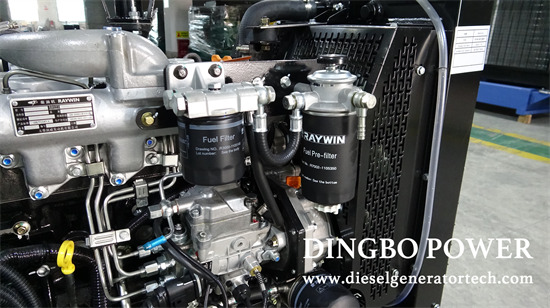The lubrication method for variable pitch reducers of generator sets is generally immersion lubrication and grease lubrication. After every 6 months of operation of the generator set, the oil quality should be checked as follows: observe the presence of water and emulsion in the oil; Check the viscosity of the oil, and if the difference exceeds 20% or decreases by 15% compared to the original, it indicates that the oil is ineffective; Check the insoluble content, which should not exceed 0.2%, and conduct an anti emulsification ability test to discover whether the oil has deteriorated; Check if the additive composition has decreased. If there are any problems, the oil should be changed or filtered.

When changing the oil, the oil is discharged from the oil drain hole and then injected into the oil injection hole. When installing the plug, thread sealant should be applied to the thread. The lubrication system should be kept clean, and measures should be taken to prevent dust, moisture, and chemicals from entering the gears and lubrication system. In cases of heavy load, high temperature, and humidity, special attention should be paid to the inspection and analysis of the oil. When the oil level in the gearbox is found to be too low, it should be replenished in a timely manner. At the input shaft and output shaft of the reducer, there are lubricating grease holes for lubrication of the bearings. The reducer is filled with lubricating grease before leaving the factory. After every 6 months of operation of the generator set, new lubricating grease should be added. When adding new grease, all old grease should be drained.
The installation and maintenance of low-voltage distribution boards should first determine the number of switches, fuses, electrical components, and instruments based on the electrical wiring diagram. Then, according to the primary and secondary relationships and control relationships of these electrical appliances, they should be evenly and symmetrically arranged on the panel surface. And it is required that the electrical appliances on the panel are arranged neatly and aesthetically, making it easy to monitor, operate, and maintain. Usually, the generator set instruments and signal lights are placed above, the frequently operated switchgear is centered, and the heavier electrical appliances are placed below. Adequate distance should be maintained between various electrical appliances to ensure safety.
Guangxi Dingbo Power Equipment Manufacturing Co.,Ltd was founded in 1974 and is one of the earliest manufacturers of generators and diesel generator sets in China. The company has a registered capital of 218.88 million yuan. The company covers an area of 86,000 square meters and a building area of 55,000 square meters. There are more than 660 employees, including 456 professional technicians and 106 senior technicians. It has 46 sales and service outlets nationwide. The main products are diesel engines, generator sets, and diesel generators, providing users with a one-stop service of design, supply, debugging and maintenance at any time. Dingbo has always insisted on using first-class talents, building first-class enterprises, manufacturing first-class products, creating first-class services, and making every effort to build a first-class domestic enterprise. If any question please feel free to visit our website https://www.dieselgeneratortech.com/ or send email to sales@dieselgeneratortech.com.
Comments
Post a Comment